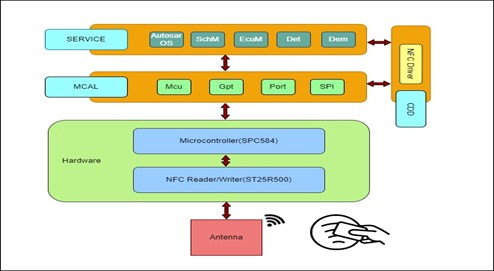Development of Complex Device Driver Based on AUTOSAR Architecture
Category : Autosar , Product Engineering
About the Customer
Our customer is a global leader in semiconductor technologies development. Known for their innovation, our customer provides solutions for automotive, industrial, personal electronics, and communication equipment.
Business Challenge
The primary challenge for the customer emerged from the need to migrate the BareMetal sensor driver software module to AUTOSAR Complex Device Driver (CDD) module.
This migration included integrating the driver into the AUTOSAR architecture, ensuring compliance with AUTOSAR specifications, and enabling the driver to interact seamlessly with other AUTOSAR software components.
Migrating a BareMetal sensor driver to an AUTOSAR Complex Device Driver (CDD) module presents several challenges:
- Compliance with AUTOSAR Standards: Ensuring the sensor driver meets AUTOSAR specifications, which may involve significant redesign and adherence to strict coding guidelines and architectural patterns.
- Integration and Interoperability: Seamlessly integrating the driver into the AUTOSAR environment, ensuring it works correctly with other AUTOSAR software components, basic software modules, and communication stacks.
- Performance Overheads: Managing potential performance overheads introduced by the AUTOSAR layers, which might impact real-time performance compared to the original BareMetal implementation.
- Resource Constraints: Adapting the driver to function efficiently within the resource constraints (memory, processing power) typical of automotive systems while adhering to AUTOSAR standards.
- Toolchain and Configuration: Utilizing AUTOSAR-compliant tools for configuration, testing, and validation, which may require a steep learning curve and adjustment to new development workflows.
- Error Handling and Diagnostics: Implementing robust error handling and diagnostic mechanisms as required by AUTOSAR, which may be more complex than the mechanisms in BareMetal systems.
- Testing and Validation: Extensive testing and validation to ensure the migrated driver performs as expected under various conditions and integrates seamlessly with other components in the AUTOSAR ecosystem.
In order to mitigate these challenges effectively, our customer was looking for a trusted embedded software development partner, also proficient in AUTOSAR architecture.
Embitel Solution
We have had the opportunity to work on CDD module development projects in the past for few of our customers.
Our following expertise and project experience was very critical for the success of this AUTOSAR project:
- Expertise in AUTOSAR CDD (Complex Device Driver) development.
- Expertise in AUTOSAR configurator tools like EB_tresos, Vector Da-Vince Configurator tools.
Counting on our CDD module development expertise gained during similar projects, we kickstarted this partnership.
Our journey with the CDD module development project began with a series of focused technology and business workshops.
These workshops brought together our team of automotive domain experts, AUTOSAR software developers, and project managers. The team was dedicated to understanding the unique requirements of the project including CDD module, the existing legacy software architecture, various software modules, and the associated hardware platforms.

In response to the needs identified during our initial assessments, our automotive AUTOSAR development team crafted and implemented a robust solution tailored to enhance the NFC reader driver module. The highlights of our solution include:
- Re-designing Software Architecture: We overhauled the existing software architecture to enable seamless integration with the AUTOSAR layered architecture, ensuring compatibility and optimizing performance.
- Support for CDD Configuration: Our team provided extensive support in creating CDD configuration files and facilitated code generation using the Tresos tool, streamlining the development process and reducing manual coding errors.
- Development of Complex Device Drivers: We developed complex device drivers specifically designed to support Non-AUTOSAR compliant software modules, enhancing the module’s versatility and functionality.
- Integration Excellence: Our solution encompassed the integration of AUTOSAR Basic Software (BSW), the Runtime Environment (RTE), and the Microcontroller Abstraction Layer (MCAL), creating a cohesive and efficient system.
- Dedicated AUTOSAR Testing Services: To ensure reliability and performance, we conducted rigorous testing at various levels, including individual module testing for the MCAL layer, integration testing, and unit testing, thereby guaranteeing a high-quality end product.
Embitel Impact
We were able to develop the complex device driver for our customer in the given timeline. The CDD module would help our customer in multiple aspects:
- Standardization: Will ensure consistency and interoperability across components, simplifying integration.
- Modularity and Reusability: Will reduce development time and costs by allowing software reuse across projects and platforms.
- Scalability: Will support adjustments in software scope for various vehicle specifications.
- Maintenance and Upgradability: Will simplify updates and maintenance, minimizing error risks.
- Integration of Third-party Software: Will ease the adoption of new technologies.
- Enhanced Diagnostics and Testing: Will Improve reliability and software quality.
- Compliance and Certification: Will facilitate adherence to industry standards, crucial for safety-critical systems.
Tools and Technologies
- Eb Tresos Tool: Tool used for configuring and generating AUTOSAR-compliant basic software modules and ECU software configurations
- Vector Da Vinci Configuration Tool: Toolset designed for the development, configuration, and validation of AUTOSAR software components and systems


















